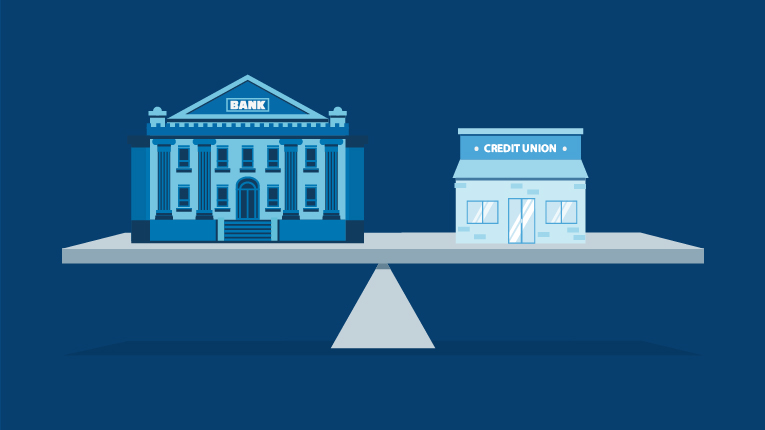FDIC vs. NCUA Insurance: Are Banks or Credit Unions Safer?

The Federal Deposit Insurance Corporation (FDIC) provides insurance for bank deposits, and the National Credit Union Administration (NCUA) does the same for credit unions. Whether you choose a bank or credit union to deposit and hold your money, your funds are generally safe.
But how are these organizations different, how do NCUA insurance and FDIC insurance work, and is one considered safer than the other? Here's everything you need to know.
What's the Difference Between FDIC Insurance vs. NCUA?
For the most part, there are few differences when it comes to NCUA insurance vs. FDIC insurance. However, there are some fine deviations between the two. Here are general guidelines on what you can expect from each:
FDIC Insurance | NCUA Insurance | |
|---|---|---|
Insured institutions | Member FDIC banks | Member NCUA credit unions |
Coverage limits | $250,000 per bank, per depositor, per account ownership category | $250,000 per credit union, per account owner, per account ownership category |
Insured products | - Checking accounts | - Checking accounts |
Products that aren't insured | - Investments, including stocks, bonds, mutual funds, and crypto assets | - Investments, including stocks, bonds, mutual funds, money market funds, and crypto assets |
What Is FDIC Insurance?
The FDIC is an agency within the U.S. government that, with the full faith and credit of the federal government, protects bank and savings association depositors against the loss of their insured deposits in the event of a bank failure. FDIC insurance is provided to bank customers as an automatic benefit—you don't need to apply or pay a premium to get it. The FDIC was created by The Banking Act of 1933 in the wake of the Great Depression to restore trust in the American banking system after thousands of banks failed because of bank runs and millions of Americans saw their life savings vanish nearly overnight. Since its inception, no bank customer has lost a penny of FDIC-insured deposits.
How FDIC Insurance Works
The FDIC requires its member banks to pay premiums into the agency's Deposit Insurance Fund (DIF) based on their liabilities. If a bank fails, the FDIC pays out insurance to the bank's depositors, typically the next business day. The federal agency may do so by providing customers with a new account and the same balance at another insured bank or by paying customers directly.
General guidelines for financial products covered by FDIC insurance.
Product | Coverage Limit |
|---|---|
Checking, savings, money market, CD, NOW, and eligible prepaid debit accounts, cashier's checks, and money orders | $250,000 per depositor, per account ownership category |
IRAs, self-directed 401(k) and profit-sharing plans, self-directed Keogh plans, and 457 plans | $250,000 per depositor |
Revocable trust accounts | $250,000 per beneficiary |
Irrevocable trust accounts | $250,000 for all contingent interests; $250,000 per beneficiary for non-contingent interests |
Pensions, defined benefit, and other employee benefit plans | $250,000 for the plan where interests are contingent; $250,000 per participant for non-contingent interests |
What Is NCUA Insurance?
The NCUA is an independent federal agency that insures deposits at federally insured credit unions, protects the members who own credit unions, and charters and regulates federal credit unions. Both the NCUA and its National Credit Union Share Insurance Fund (NCUSIF) were created by Congress in 1970. Up until that time, credit unions were not federally insured. Deposits are covered by the NCUA automatically with a member credit union. Since its inception, no credit union member has lost a penny of NCUA-insured deposits.
How NCUA Insurance Works
The NCUA provides insurance coverage only to credit unions with sound operational standards. As a result, insured institutions rarely fail. In the event that a credit union does fail, the NCUA will typically pay out coverage from the NCUSIF, which is funded by participating credit unions, directly to members within a few days.
General guidelines for financial products covered by NCUA insurance.
Product | Coverage Limit |
|---|---|
Checking, savings, money market, and CD accounts, cashier’s checks, and money orders | $250,000 per depositor, per account ownership category |
IRAs | $250,000 per depositor |
Keogh plans | $250,000 per depositor |
Revocable trust accounts | $250,000 per beneficiary |
Irrevocable trust accounts | $250,000 for all contingent interests, $250,000 per beneficiary for non-contingent interests |
Which Is Safer: Banks or Credit Unions?
In terms of the safety of your deposits, for most Americans there isn’t much difference between banks and credit unions. However, because credit unions serve mostly individuals and small businesses (rather than large investors) and are known to take fewer risks, credit unions are generally viewed as safer than banks in the event of a collapse. Regardless, both types of financial institutions are equally protected.
When choosing between a bank or credit union, it’s best to base your decision on the specific features of a financial institution’s products and services and how well they are likely to serve your needs. Consider what you're looking for in a banking experience, then research and compare options based on their account features, fees, access to funds, customer service, and whatever else is important to you. Also, remain aware of the dollar limits for insurance and factor that into your choice.
The Bottom Line
If you're concerned about the safety of your money, make sure the bank or credit union is a member of the FDIC or NCUA, respectively. This will help ensure that your funds are protected (within coverage limits) if the financial institution fails.
As you compare your options, consider LendingClub Bank's Rewards Checking and High-Yield Savings accounts—both of which are FDIC-insured up to the maximum amount allowed ($250,000 per depositor for each ownership category) and also offer other valuable features, including no monthly maintenance fees and more.
NCUA Insurance vs. FDIC Insurance FAQs
Here are some of the most common questions and answers about NCUA insurance vs. FDIC.
Which is safer: NCUA or FDIC?
Both the NCUA and FDIC provide a degree of safety and security against financial institution failures. While there are some minor differences in coverage between NCUA and FDIC, they’re equal in terms of protection for most Americans.
Do both FDIC and NCUA insure accounts for up to $250,000?
Yes, the maximum coverage per institution, per depositor, per account ownership category is $250,000. However, it is possible to structure accounts across different ownership categories such that each account category could have maximum coverage. For example, one way is to have a joint account in which each person would receive the $250,000 coverage limit.
Additionally, you can stack the limit across different account ownership categories. For example, you can get $250,000 in an individual account and another $250,000 in a joint account with the same bank or credit union. To calculate what’s insured and what portion (if any) exceeds coverage limits for all types of deposit accounts offered by an FDIC-insured bank, use the FDIC’s Electronic Deposit Insurance Estimator (EDIE).
Also, some companies offer bank accounts that spread deposits across multiple financial institutions, taking advantage of the "per bank" or "per credit union" coverage qualifier to offer more coverage. Talk to your financial institution to better understand how to maximize coverage.
What does the NCUA not cover?
Like the FDIC, the NCUA doesn't cover insurance products or investments, even if you purchased them through the participating bank or credit union. Annuities, safe deposit boxes, and U.S. Treasury bills, notes, and bonds are also excluded from coverage, even if they're offered by a federally insured financial institution.
Can you be FDIC-insured at multiple banks?
Yes. You can receive $250,000 in coverage with each member bank that you use to deposit your funds. Some financial technology companies and other companies use that qualifier to offer as much as $3 million in coverage in some cases.




